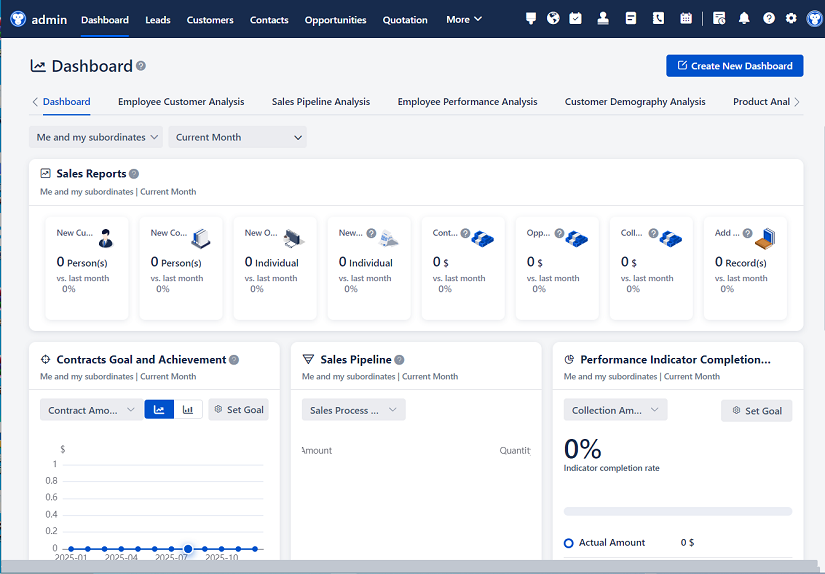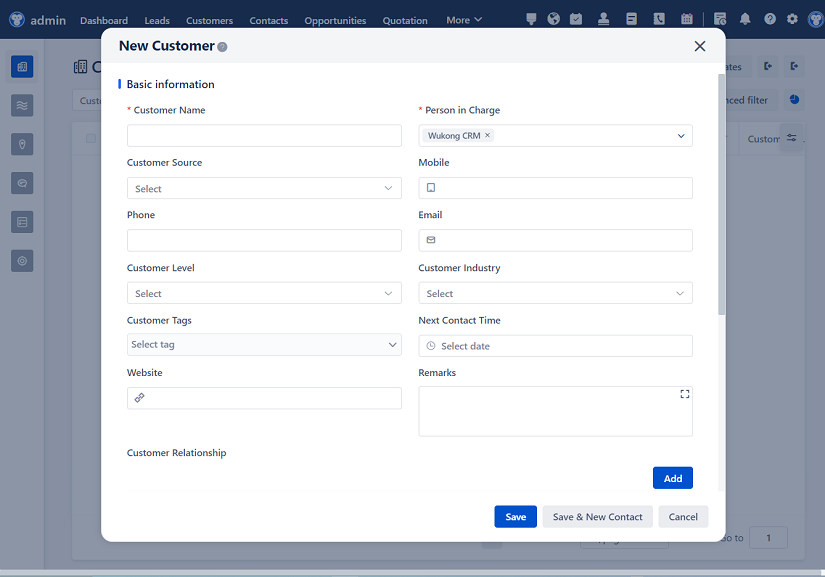
△Click on the top right corner to try Wukong CRM for free
You know, I’ve been thinking a lot lately about how businesses today are trying to connect with customers in smarter ways. It’s not just about throwing ads out there and hoping something sticks anymore. People have gotten way too savvy for that. Instead, companies are turning to data—real, meaningful data—to figure out what their customers actually want. And honestly, one of the most powerful tools they’re using is CRM, or Customer Relationship Management systems.

Free use of CRM system: Free CRM
I mean, think about it. Every time someone visits a website, makes a purchase, signs up for a newsletter, or even just clicks on an email—that’s all data. And when you collect enough of it, patterns start to emerge. You begin to see who your best customers are, what products they love, when they’re most likely to buy, and even why they might stop engaging. That kind of insight? That’s gold.
But here’s the thing: having a CRM system isn’t enough. I’ve seen so many companies invest in fancy software only to let it sit there like a digital paperweight. The real magic happens when you actually use the data from your CRM to shape your marketing strategies. That’s what we call data-driven marketing.
Let me give you an example. Imagine you run an online clothing store. Your CRM shows that a certain group of customers—mostly women aged 28 to 35—keeps coming back every three months to buy new workout gear. They open your emails, click through to product pages, but sometimes they abandon their carts. Now, instead of sending them the same generic “10% off everything” promo, you could create a targeted campaign just for them. Maybe offer free shipping on their next order or send a personalized message saying, “We noticed you left something behind—here’s 15% off to complete your look.”
See how much more personal that feels? That’s the power of data-driven marketing based on CRM. It’s not about blasting messages into the void. It’s about having real conversations with real people, using what you know about them to make those interactions meaningful.

And the cool part? This isn’t just for big corporations with massive budgets. Even small businesses can get in on this. A local coffee shop, for instance, could use their CRM to track which customers come in every Monday morning, order the same drink, and maybe follow them on Instagram. Then, they could surprise those regulars with a “Happy Monday” coupon or invite them to a special tasting event. It builds loyalty, makes people feel seen, and honestly, it just feels good.
Now, I should mention—this only works if your data is clean and organized. I’ve talked to marketers who were frustrated because their campaigns weren’t performing, and when we dug into it, their CRM was a mess. Duplicate entries, outdated contact info, missing purchase histories—you can’t build smart strategies on shaky foundations. So yeah, take the time to clean up your data. Trust me, it’s worth it.
Another thing I’ve noticed is that people often forget CRM isn’t just about sales history. It’s also about behavior. Did a customer spend five minutes reading your blog post about sustainable fashion? That tells you something. Did they watch a product video but didn’t buy? That’s a signal too. When you combine transactional data with behavioral data, you start to get a full picture of the customer journey.
And once you understand that journey, you can map out personalized touchpoints. For example, someone who’s shown interest in eco-friendly products might appreciate content about your brand’s sustainability efforts. Send them a case study, a behind-the-scenes video, or an invitation to a webinar. It’s not a hard sell—it’s value-added communication that strengthens the relationship.
One of the biggest advantages of data-driven marketing through CRM is timing. I can’t tell you how many times I’ve gotten an email promotion two weeks after I already bought the item. Frustrating, right? But with CRM data, you can set up automated workflows that trigger based on behavior. Bought a pair of running shoes? Great—follow up in four weeks with tips on choosing the right socks or maintaining your footwear. Not only does this keep your brand top-of-mind, but it positions you as helpful, not pushy.
And let’s talk segmentation. This is where CRM really shines. Instead of treating all customers the same, you can break them into groups based on demographics, purchase history, engagement level, or even predicted lifetime value. High-value customers might get exclusive early access to sales or VIP events. New subscribers could receive a welcome series that introduces them to your brand story and bestsellers. Inactive users? Maybe they need a re-engagement campaign with a special incentive to come back.
I remember working with a skincare brand that used CRM data to identify customers who had purchased anti-aging products but hadn’t reordered in six months. Instead of assuming they’d lost interest, the team sent a gentle check-in email: “We miss you! Here’s what’s new in our anti-aging line.” They included before-and-after photos, customer testimonials, and a limited-time discount. The result? A 22% reactivation rate. That’s huge.
Of course, none of this works without consent and transparency. People are rightfully cautious about how their data is used. So be upfront. Let them know you’re collecting information to improve their experience. Give them control over their preferences. And never, ever spam them. Respect goes a long way in building trust.
Another thing I’ve learned is that data-driven marketing isn’t a one-and-done deal. It’s ongoing. You launch a campaign, measure the results, learn from what worked (and what didn’t), and then tweak your approach. CRM systems make this easier because they track everything—open rates, click-throughs, conversions, even social media interactions. Over time, you start to see trends. Maybe emails sent on Tuesday mornings perform better. Or perhaps video content drives more engagement than static images. Use those insights to refine your strategy continuously.
And don’t forget about cross-channel integration. Your CRM should talk to your email platform, your social media tools, your website analytics, and even your customer service software. When all these systems are connected, you get a unified view of the customer. No more silos. No more confusion. Just one clear, consistent experience across every touchpoint.
I’ll admit, setting this up takes effort. You might need to train your team, adjust your processes, or invest in better technology. But the payoff is real. Companies that use CRM-driven marketing strategies report higher customer retention, increased average order values, and stronger brand loyalty. Plus, your marketing budget goes further because you’re focusing on people who are actually interested in what you offer.
One last thing—don’t overlook the emotional side of this. At the end of the day, marketing is about human connection. Data helps you scale that connection, but it doesn’t replace it. The goal isn’t to turn customers into numbers. It’s to use numbers to treat them like individuals. To remember their names, their preferences, their stories. That’s what creates lasting relationships.
So if you’re sitting there wondering whether to dive into data-driven marketing with your CRM, my advice is simple: start small. Pick one customer segment. Run one targeted campaign. Measure the results. Learn. Adjust. Then do it again. You don’t need perfection on day one. You just need to begin.
Because here’s the truth—customers don’t expect brands to be perfect. They expect them to care. And when you use CRM data thoughtfully, you show that you do.
FAQs (Frequently Asked Questions):
Q: What exactly is a CRM system?
A: A CRM—Customer Relationship Management system—is a tool that helps businesses manage interactions with current and potential customers. It stores contact info, purchase history, communication logs, and behavioral data, all in one place.
Q: Can small businesses benefit from CRM-based marketing?
Absolutely. In fact, small businesses often see faster returns because they can be more agile and personalize experiences more easily. Many CRM platforms now offer affordable plans tailored for smaller teams.
Q: Is data-driven marketing invasive or creepy?
It can be—if done poorly. But when you’re transparent, respectful, and focused on adding value, customers usually appreciate the relevance. The key is permission and personalization without overstepping.
Q: How do I get started with data-driven marketing using CRM?
Start by cleaning your existing customer data, then define clear goals—like increasing retention or boosting email engagement. Choose a CRM that fits your needs, integrate it with your other tools, and begin testing small, targeted campaigns.
Q: What kind of data should I collect in my CRM?
Focus on essential info like contact details, purchase history, website behavior, email engagement, and customer preferences. Avoid collecting unnecessary data—only gather what you’ll actually use to improve the customer experience.
Q: How often should I analyze my CRM data?
Regularly! Set a schedule—weekly or monthly—to review performance metrics, spot trends, and adjust your strategies. The more frequently you check in, the more responsive and effective your marketing becomes.
Q: Can CRM help with customer service too?
Definitely. A good CRM gives support teams instant access to customer history, making it easier to resolve issues quickly and personally. It bridges the gap between marketing, sales, and service.
Q: What if my team resists using CRM data for marketing?
Change can be tough. Start by showing quick wins—like improved open rates or higher conversion from a test campaign. Training and clear communication about the benefits can also help overcome resistance.
Q: Does data-driven marketing work for B2B companies?
Yes, especially in B2B. Decision-making cycles are longer, so understanding customer behavior, engagement levels, and pain points through CRM data is incredibly valuable for nurturing leads.

Q: How do I measure the success of my CRM-based marketing campaigns?
Track KPIs like customer acquisition cost, retention rate, average order value, email click-through rates, and overall ROI. Most CRM platforms include built-in reporting tools to help you monitor progress.
Related links:
Free trial of CRM
Understand CRM software

△Click on the top right corner to try Wukong CRM for free